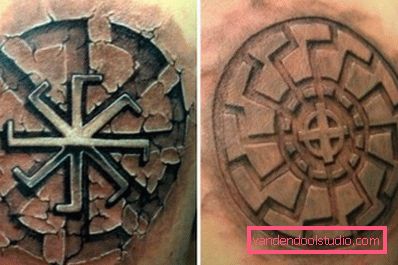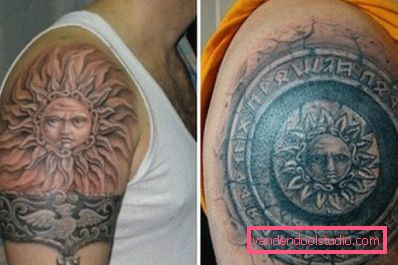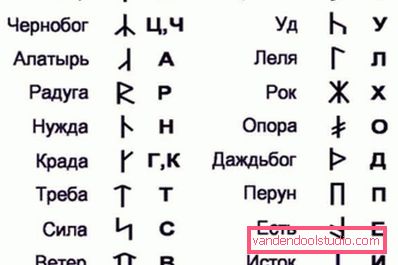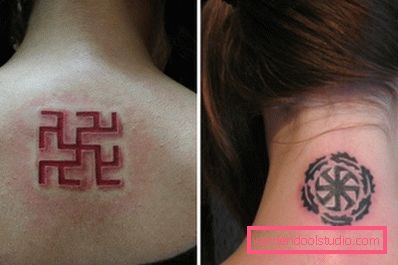Slavic tattoos - underwear painting of our ancestors

In recent years, one can notice the rebirth of Slavic culture. Many young people began to study the history of ancient states and to be interested in how our ancestors lived. Symbolism in those days gave great importance. Before the advent of Christianity, pagan worship was distinguished by a variety of different signs, runes, ornaments, and amulets. Decorated them and the body.
WITHThe lava tattoos were made by those people who were especially reverent in their faith and loved nature. Such images were peculiar to both men and women. Currently, such drawings are becoming more popular and are finding more and more fans.
Slavic tattoos in antiquity and in modern times
Until now, there is no exact data on whether our ancestors inflicted wearable pictures, because during the excavations no ancient burial was found intact. But studies prove that Slavic tattoos existed.

The writings of an Arabic traveler of the 10th century named Ibn Fadlan, who reports that he noticed some representatives of the peoples who settled along the Volga, preserved drawings that occupy skin from hands to neck. Also, the traveler met various ornaments, images of animals and birds.
The culture and faith of the Slavs were built on the forces of four elements, each of which had its own meaning and its own symbols: air, water, earth, and fire. Man could not control these elements and subordinate them to himself. This caused a certain fear and apprehension. Since it was impossible to tame, people believed that it was necessary to bring gifts, pray and worship. Then the gods of the elements will be gracious to them. That is why these symbols decorated houses, put them on armor and weapons. It is possible that such symbols were pinned on the body.

Slavs treated nature with special trepidation. Tree worship was practiced. Therefore, now on the bodies of modern people can be found tattoos in the form of trees. With the advent of Christianity, paganism was recognized as a demonic religion, and symbolism, cults and rituals were completely banned. Tattoo in the Slavic style began to be forgotten. Much time has passed, and now they have begun to gain popularity again, thanks to their beauty, attractiveness and deep symbolism.

Modern sketches of Slavic tattoos have a number of features:
- In one image, Celtic, Slavic and Scythian motifs can be combined at the same time. Pure Slavic pattern is distinguished by the combination of rhombuses, crosses, spirals, dots and commas. More recently, plant and flower motifs have been included in drawings;
- Compositions are complemented by elements of book ornaments, which are created by combining the original Russian and Christian traditions;
- The basis of the picture are the plots and motifs of Russian folklore;

- The drawing is complemented by various artistic components: elements of painting under palekh, Gzhel, Khokhloma, as well as parts of scenes from paintings by such artists as Vasilyev or Vasnetsov;
- Runes, charms and images of ancient Slavic deities are among the most popular sketches. Consider them in more detail.
Runic symbolism
In the photo you can see that the runes are quite often chosen as a tattoo and guys, and girls. These signs, similar to hieroglyphs, were elements of the Slavic script of the schismatics and carried the deepest historical meaning. Each rune has its own interpretation and has a mysterious unique image. Of them create the whole inscription, or used as an addition to large compositions.

Before you apply a certain rune on the body, you need to accurately determine its value. According to beliefs, each such symbol has a certain magical load, which can affect the future life path.
The most popular runes and their interpretation:
- World. The patronage of God, the desire for order;
- Rainbow. The road leading to the center of the universe. This symbol brings good luck in traveling and helps to find a way out of difficult situations;
- Strength. Symbolizes bravery, victory, integrity and power. Previously, it was inflicted by warriors;
- Wind. Impersonation of the air, giving inspiration and creative power;
- There is. The symbol of the fact that life does not stand still;
- Perun. Power, life energy, power;
- Bereginya. One of the runes for girls, personifying the feminine and fertility;
- Lelya Female symbol for joy, flowering and intuition.

This is not a complete list. Everyone can choose a rune that will be associated with the character and internal qualities. It is necessary to approach the choice very responsibly.
Swastika
Another integral attribute of ancient Slavic culture. Various swastikas were used at that time as amulets. This ornament has a different shape and angularity.

It is based on a cross with clockwise curved edges that symbolize the eternal movement of life: from day to night, from birth to death. It is often compared with the symbolism of the Nazis, but these are completely different things. Now such "tattoo Slavic amulets" very popular. Here is a description of some of them:
- Valkyrie. Protection of native lands, honor and nobility;
- The Goddess. Self-improvement and protection of the gods;
- Weddings Family unity;
- Overcome the grass. Protection against bodily and spiritual ailments;

- Dunia Protection of the genus;
- Ratiborets. Courage and courage;
- Slavets. Charm for girls, protection of family and offspring.
Images of gods
Pagan faith assumed a large list of deities worshiped by the Old Believers before the advent of Christianity. Now tattoos with faces of the gods are stylized as images of strong, courageous men, similar to typical Vikings. Such pictures are perfect for guys of dense build.
- Perun. The main deity, the thunderbird, who throws lightning at his enemies;
- Veles Keeper of forests, patron of medicine, poetry and creativity;

- Svarog. God of heavenly forces, patron of blacksmithing;
- Yarilo. The symbol of the sun and fertility.
Slavic men's tattoos
Slavic pagans believed that wearable drawings should not be applied until the man reaches the age of 33 years. It is up to this time that the development of the body and spirit takes place.
Now, as before, the representatives of the stronger sex choose tattoos, personifying power and strength. Popular images of Slavic male gods. Most often they pin up the image of Perun or the god Yarylo. Often you can see wearable pictures in the form of warriors, combatants, as well as scenes from battles and battles. Tattoo with animals are also in demand. The leading places are occupied by the bear and the wolf.

From the runes men mainly choose the military sign "Treba", the symbol "Wind", the rune "Oud", symbolizing the male principle. Those who travel a lot and learn about the world, puncture the "Is" sign.
Slavic tattoo for girls
In times of paganism, women often punctuated crosses on their chests. Girls in ancient Russia, who wanted to have many children, chose the Dazhbog rune. "Support" - another symbol for girls, acting as a talisman for the family and the hearth.

Previously, the sign "Lelya" was not held in high esteem among women, because it means wandering and lack of reference to a specific location. But for modern ladies, who lead an active lifestyle, who love traveling and are looking for new impressions, this fleece is very suitable.
Of the swastik symbols, the “Slavec” was often chosen - an image similar to a kolovrat. It acted as a guardian of women's health.

Slavic subjects every year becomes more and more popular. Tattoos are no exception. Before you decide to make a tattoo, you need to carefully consider the sketch and find out its interpretation. After all, according to popular belief, the wrong Slavic tattoo can completely turn life, both for the better and for the worse. You should not apply the image yourself and at home. It is better to contact a master who specializes in Old Slavic topics. He will apply a tattoo step by step, following the scheme and following all the instructions. As a result, you will receive an image with a deep meaning, which will inhale in you a piece of the culture of the ancient Slavs.